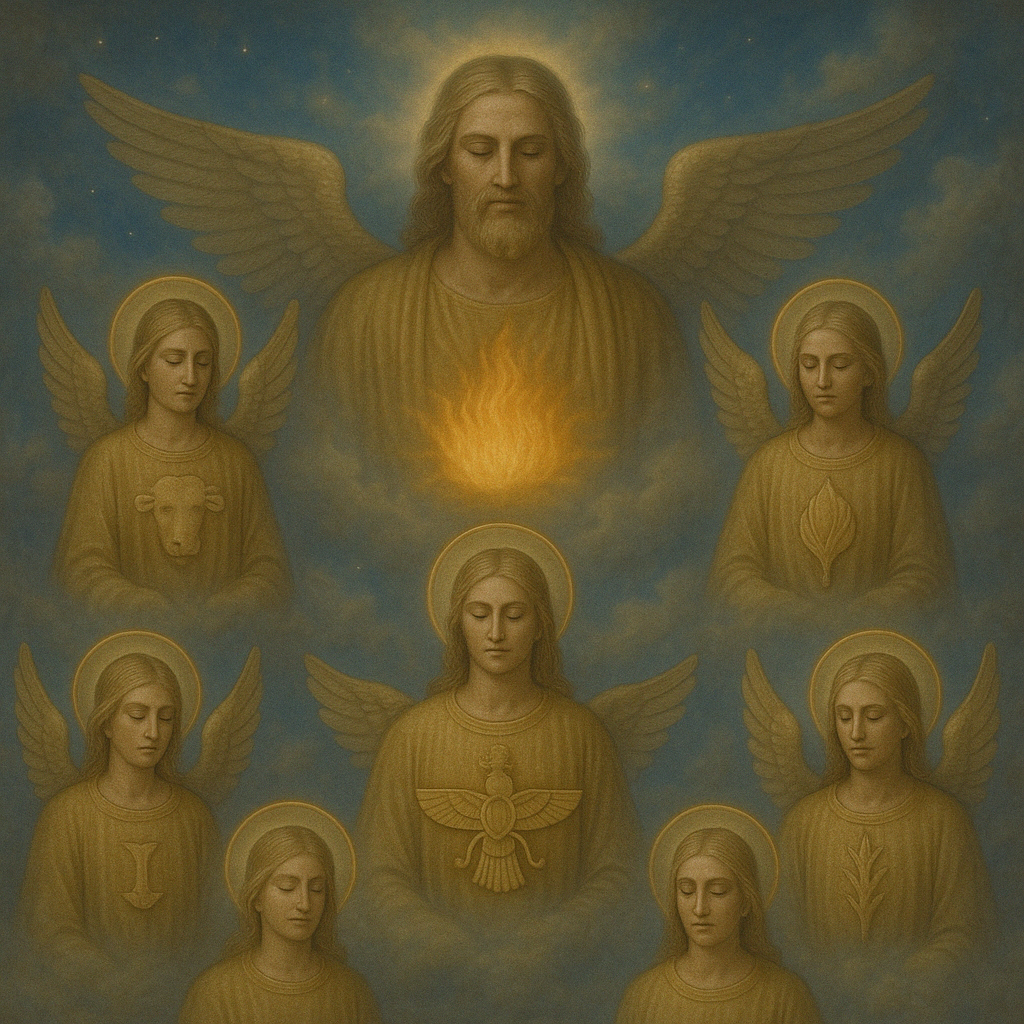Overview
Zoroastrian angelology is the study of the celestial beings in Zoroastrianism, one of the world’s oldest monotheistic religions, founded by the prophet Zarathustra (Zoroaster) around 1500–1000 BCE in ancient Persia. Zoroastrian cosmology describes a spiritual universe composed of divine beings who assist in maintaining order (Asha) and opposing chaos (Druj). These celestial beings function similarly to angels in other traditions, serving as divine emanations, cosmic intelligences, and spiritual helpers in the struggle between light and darkness.
The Zoroastrian concept of angelic forces includes Amesha Spentas (Holy Immortals), Yazatas (Venerable Ones), and a range of spiritual forces that bridge the divine and material worlds.
Key Principles of Zoroastrian Angelology
- Monotheistic Core: All celestial beings emanate from Ahura Mazda, the supreme Creator and source of all goodness and order.
- Dualism and Divine Order: Zoroastrian cosmology is framed as a spiritual battle between Asha (Truth, Divine Order) and Druj (Lie, Chaos), with angels acting as agents of Asha.
- Free Will: Both humans and divine beings play an active role in choosing and manifesting truth or falsehood.
- Spiritual Hierarchy: Celestial beings are arranged in a divine structure, with specific domains over natural elements, moral virtues, and cosmic functions.
1. Amesha Spentas – The Holy Immortals
The Amesha Spentas are the highest order of spiritual beings and aspects of Ahura Mazda’s divine essence. Each represents a virtue and governs a part of the cosmos. They are comparable to archangels in other traditions.
| Amesha Spenta | Domain | Aspect of Ahura Mazda |
|---|---|---|
| Vohu Manah | Good Mind / Compassion | Divine Thought |
| Asha Vahishta | Truth, Fire, and Order | Divine Law |
| Khshathra Vairya | Divine Kingdom / Sovereignty | Divine Power |
| Spenta Armaiti | Devotion, Earth, and Peace | Divine Devotion |
| Haurvatat | Wholeness and Water | Divine Health |
| Ameretat | Immortality and Plants | Divine Eternity |
| Ahura Mazda | Supreme Consciousness | Unity and Source |
Each Amesha Spenta also governs a direction and a day of the Zoroastrian calendar, reinforcing the rhythm of sacred time and space.
2. Yazatas – Venerable Beings
The Yazatas are divinities who are worthy of worship and veneration. While subordinate to the Amesha Spentas, they are powerful spiritual beings assigned to natural elements, stars, virtues, and divine forces.
| Yazata | Function and Symbolism |
|---|---|
| Mithra | Guardian of contracts, sunlight, justice |
| Sraosha (Srosh) | Angel of divine conscience, protector of souls |
| Rashnu | Angel of truth and judgment |
| Atar | Fire spirit and purity |
| Haoma | Spirit of the sacred plant and divine vitality |
| Anahita | Goddess of waters, fertility, and wisdom |
| Tishtrya | Star deity (Sirius), brings rain and fertility |
| Verethragna | Angel of victory and courage |
Many Yazatas serve as divine intercessors, mediators of prayers, and guardians of the soul during key life transitions, especially at death.
3. Spiritual Beings and Forces of Asha
- Fravashis (Fravarti): Guardian spirits or higher selves of individuals, both living and deceased. They protect the soul and uphold divine purpose.
- Ahuras vs. Daevas:
- Ahuras are benevolent spiritual lords aligned with truth and order.
- Daevas, once part of the divine host, chose falsehood and now represent chaos, similar to demons or fallen angels in other traditions.
- Sraosha is particularly important in maintaining moral vigilance, whispering divine truth into the human mind, and guiding souls at the moment of death.
The Role of Angels in Human Life
| Role | Description |
|---|---|
| Moral Guidance | Angels help humans align with Asha and resist the influence of Druj. |
| Protection | Guardian beings like Sraosha and Fravashis protect individuals during life and escort the soul at death. |
| Intercession | Yazatas receive prayers and deliver them to Ahura Mazda. |
| Cosmic Harmony | Angels oversee natural phenomena (fire, water, stars) to keep the world in sacred balance. |
| Judgment and Truth | Rashnu weighs the soul’s deeds after death in the presence of Mithra and Sraosha. |
Afterlife and Judgment
- Upon death, the soul is judged at the Chinvat Bridge by Rashnu, Sraosha, and Mithra.
- Those who lived in alignment with Asha pass the bridge and enter the House of Song (paradise).
- Those who embraced Druj fall into darkness and chaos until eventual purification.
Comparisons with Other Angelologies
| Tradition | Equivalent Concepts |
|---|---|
| Christianity | Archangels (Michael, Gabriel) = Amesha Spentas; Guardian angels = Fravashis |
| Islam | Angels (Mīkāʾīl, Isrāfīl) as Yazatas |
| Kabbalah | Sephiroth as aspects of Divine; angels as planetary or elemental forces |
| Hinduism | Devas and Lokapalas as divine guardians and elemental spirits |
Practices and Devotion
Zoroastrians honor the angelic beings through:
- Daily prayers called Gathas and Yashts dedicated to specific Amesha Spentas or Yazatas.
- Sacred fire rituals, as fire represents spiritual light and the ever-burning presence of Ahura Mazda and the Amesha Spentas.
- Observance of festivals and holy days aligned with the cosmic calendar and angelic guardians.
Related Topics
Comparative Angelology Across Traditions
Amesha Spentas and the Divine Mind
The Chinvat Bridge and Soul Judgment
Fravashis and Guardian Spirits

